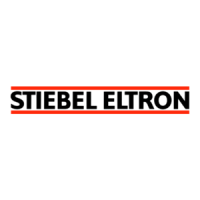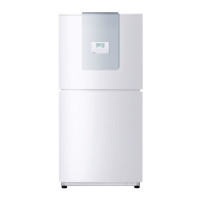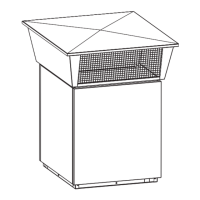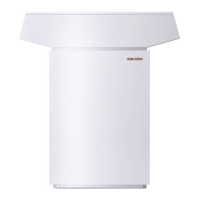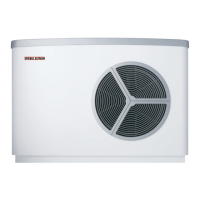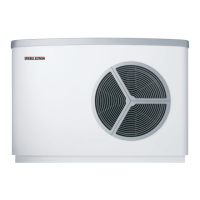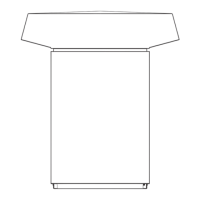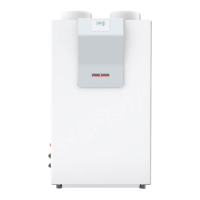8
26_03_01_0064
1390
800
360
70
220
50
Hauptwindrichtung
Luftaustrittseite
Lufteintrittseite
1200
650
Hauptwindrichtung
Luftaustrittseite
Lufteintrittseite
Fig. 5
Foundation for external installation
when using pressure hoses
Curb stones for external
installation
Dimensions in mm
1 Impact sound installation
2 Floating screed
1
2
Fig. 6
Fig. 4
Recess screed and impact sound insulation.
Dimensions in mm
Where the heat pump is installed on strip
foundations, seal off the open sides of the
foundation.
3.3.2 Noise emissions in case of internal
installation
Where possible, install the heat pump in a cel-
lar or on the first floor, but never immediately
below or adjacent to living rooms or bed-
rooms. Never install the heat pump on joists.
The sound power level in internal installations
is 58 dB(A) inside the installation room and
62 dB(A) at the air inlet and outlet openings.
Connect the heating flow and return pipes
using flexible pressure hoses (anti-vibration
measure) (part no. see section 1.6). Protect
all pipe fixings and wall transitions with anti-
vibration insulation. Never direct the air inlet
and outlet apertures in external walls towards
neighbouring windows or living rooms/bed-
rooms.
3.4 Installing the base unit
The heat pump must be accessible from all
sides.
Position the base unit on the substrate pre-
pared in accordance with section 3.2. Observe
the required air outlet direction. After install-
ing the heat pump, tighten the pipe fittings on
the pressure and inlet lines of the compressor
with a torque of 100 Nm (Fig. 8, item 10/11).
3.5 Base unit installation
With external installations, water and electri-
cal pipes/cables can be routed into the heat
pump through the bottom, i.e. through the
knock-outs in the floor of the refrigeration
drive.
Water and electrical pipes/cables are routed
into the heat pump from the top (see Fig. 8).
When water pipes are routed through the top,
cut out the caps in the cover (Fig. 8, item 8).
Observe section 4 „Electrical connection“
when routing the electrical cables.
3.6 Heating water connection
3.6.1 The heat pump heating system must
be installed by a qualified contractor in
accordance with the water installation
drawings, which are part of the engineering
documents.
With regard to the safety equipment of the
heating system, observe
DIN EN 12828 plus TRD 721 safety equipment.
In dual-mode operation, the return water of
the second heat source can flow through the
heat pump. The return water temperature
may be a max. of 60 °C.
3.6.2 Protection of heating water pipes against
frost and moisture
(only for external installation)
Protect the flow and return pipes in external
installation against frost by means of adequate
thermal insulation, and by routing them inside
conduit against moisture (Fig. 7).
Maintain the required insulation thickness in
accordance with the Heating System Order [or
local regulations].
The integral frost protection control (inside the
heat pump), which automatically starts the
circulation pump in the heat pump circuit at +
8 °C and thereby safeguards circulation in all
water-bearing components, offers additional
frost protection. The heat pump is started au-
tomatically no later than from +5 °C onwards,
if the temperature inside the buffer cylinder
drops.
3.6.3 Flow and return connection
Connect the heating water side of the heat
pump in accordance with Fig. 7 (external
installation) or Fig. 8 (internal installation).
Check for leaks. For external and internal in-
stallations, first connect the pipe bend (item
8, Fig. 7 and 8), which is supplied as part of
the casing accessories, to the connector from
the heating flow or return (item 9, Fig. 7 and
8). Connect anti-vibration pipes of at least
1 m length to the connector G 1¼“ (male).
Structure-borne noise is substantially pre-
vented by the anti-vibration construction of the
heat pump and by the flexible pressure hoses,
which act as anti-vibration mounts. .
For internal installation, connect the pipe bend
(item 4 in Fig. 8), which is supplied as part of
the casing accessories, to the heating return
connector (item 5).
Connect anti-vibration mounts of at least 1 m
length to the connector G 1¼“ (male).
Structure-borne noise is substantially pre-
vented by the anti-vibration construction of the
heat pump and by the flexible pressure hoses,
which act as anti-vibration mounts.
Air outlet side
Air inlet side
Main wind direction
Air outlet side
Main wind direction
Air inlet side
C26_03_01_0663
26_03_01_0668
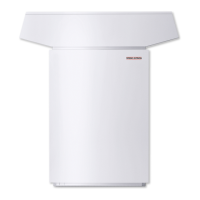
